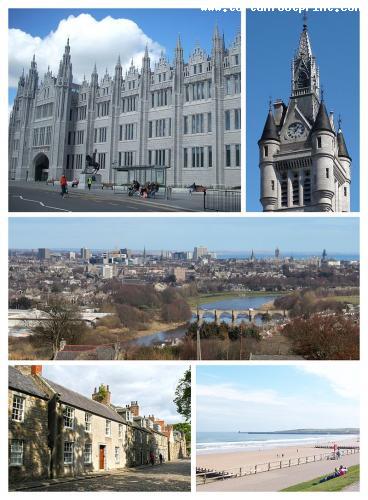You seem to be using an older version of Internet Explorer. This site requires Internet Explorer 8 or higher. Update your browser here today to fully enjoy all the marvels of this site.
November 8, 2018 by Alexander Meldrum
Scotlands Citys
Aberdeen (/æbərˈdiːn/ (About this sound listen); Scots: Aiberdeen, About this sound listen (help·info); Scottish Gaelic: Obar Dheathain [opəɾ ˈɛ.ɛɲ]; Latin: Aberdonia) is a city in ...Scotlands Citys
Aberdeen (/æbərˈdiːn/ (About this sound listen); Scots: Aiberdeen, About this sound listen (help·info); Scottish Gaelic: Obar Dheathain [opəɾ ˈɛ.ɛɲ]; Latin: Aberdonia) is a city in northeast Scotland.
It is Scotland's third most populous city, one of Scotland's 32 local government council areas and the United Kingdom's 37th most populous built-up area, with an official population estimate of 196,670 for the city of Aberdeen and 228,800 for the local council area. During the mid-18th to mid-20th centuries, Aberdeen's buildings incorporated locally quarried grey granite, which can sparkle like silver because of its high mica content. Since the discovery of North Sea oil in the 1970s, Aberdeen has been known as the off-shore oil capital of Europe. The area around Aberdeen has been settled since at least 8,000 years ago when prehistoric villages lay around the mouths of the rivers, Dee and Don.
The city has a long, sandy coastline and a marine climate, the latter resulting in chilly summers and mild winters.
Aberdeen received Royal Burgh status from David I of Scotland (1124–1153), transforming the city economically.
The city's two universities, the University of Aberdeen, founded in 1495, and Robert Gordon University, which was awarded university status in 1992, make Aberdeen the educational centre of the north-east of Scotland.
The traditional industries of fishing, paper-making, shipbuilding, and textiles have been overtaken by the oil industry and Aberdeen's seaport.
Aberdeen Heliport is one of the busiest commercial heliports in the world and the seaport is the largest in the north-east of Scotland. Aberdeen hosts the Aberdeen International Youth Festival, a major international event which attracts up to 1000 of the most talented young performing arts companies.
In 2015, Mercer named Aberdeen the 57th most liveable city in the world, as well as the fourth most liveable city in Britain.
In 2012, HSBC named Aberdeen as a leading business hub and one of eight 'super cities' spearheading the UK's economy, marking it as the only city in Scotland to receive this accolade. In 2018, Aberdeen was found to be the best city in the UK to start a business in a study released by card payment firm Paymentsense.
History
The Aberdeen area has seen human settlement for at least 8,000 years. The city began as two separate burghs: Old Aberdeen at the mouth of the river Don; and New Aberdeen, a fishing and trading settlement, where the Denburn waterway entered the river Dee estuary. The earliest charter was granted by William the Lion in 1179 and confirmed the corporate rights granted by David I.
In 1319, the Great Charter of Robert the Bruce transformed Aberdeen into a property-owning and financially independent community. Granted with it was the nearby Forest of Stocket, whose income formed the basis for the city's Common Good Fund which still benefits Aberdonians.
During the Wars of Scottish Independence, Aberdeen was under English rule, so Robert the Bruce laid siege to Aberdeen Castle before destroying it in 1308, followed by the massacring of the English garrison. The city was burned by Edward III of England in 1336, but was rebuilt and extended. The city was strongly fortified to prevent attacks by neighbouring lords, but the gates were removed by 1770. During the Wars of the Three Kingdoms of 1644 to 1647 the city was plundered by both sides. In 1644, it was taken and ransacked by Royalist troops after the Battle of Aberdeen and two years later it was stormed by a Royalist force under the command of the Marquis of Huntly.In 1647 an outbreak of bubonic plague killed a quarter of the population. In the 18th century, a new Town Hall was built and the first social services appeared with the Infirmary at Woolmanhill in 1742 and the Lunatic Asylum in 1779. The council began major road improvements at the end of the 18th century with the main thoroughfares of George Street, King Street and Union Street all completed at the beginning of the 19th century. The expensive infrastructure works led to the city becoming bankrupt in 1817 during the Post-Napoleonic depression, an economic downturn immediately after the Napoleonic Wars; but the city's prosperity later recovered.
The increasing economic importance of Aberdeen and the development of the shipbuilding and fishing industries led to the construction of the present harbour including Victoria Dock and the South Breakwater, and the extension of the North Pier. Gas street lighting arrived in 1824 and an enhanced water supply appeared in 1830 when water was pumped from the Dee to a reservoir in Union Place. An underground sewer system replaced open sewers in 1865.
The city was incorporated in 1891. Although Old Aberdeen has a separate history and still holds its ancient charter, it is no longer officially independent. It is an integral part of the city, as is Woodside and the Royal Burgh of Torry to the south of the River Dee.
Go to Wikipedia for full History
In this photo:


